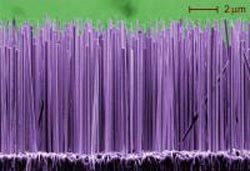Growing glowing nanowires to light up the nanoworld

Growing, glowing nanowires. Credit: Lorelle Mansfield/NIST
The nano world is getting brighter. Nanowires made of semiconductor materials are being used to make prototype lasers and light-emitting diodes with emission apertures roughly 100 nm in diameter–about 50 times narrower than conventional counterparts. Nanolight sources may have many applications, including “lab on a chip” devices for identifying chemicals and biological agents, scanning-probe microscope tips for imaging objects smaller than is currently possible, or ultra-precise tools for laser surgery and electronics manufacturing.
Researchers at the National Institute of Standards and Technology (NIST) are growing nanowires made of gallium nitride alloys and making prototype devices and nanometrology tools. The wires are grown under high vacuum by depositing atoms layer by layer on a silicon crystal. NIST is one of few laboratories capable of growing such semiconductor nanowires without using metal catalysts, an approach believed to enhance luminescence and flexibility in crystal design. The wires are generally between 30 and 500 nanometers (nm) in diameter and up to 12 micrometers long. When excited with a laser or electric current, the wires emit an intense glow in the ultraviolet or visible parts of the spectrum, depending on the alloy composition.
A paper in the May 22 issue of Applied Physics Letters* reports that individual nanowires grown at NIST produce sufficiently intense light to enable reliable room-temperature measurements of their important characteristics. For example, the peak wavelength of light emitted with electric field parallel to the long axis of a nanowire is shifted with respect to the peak wavelength emitted with electric field perpendicular to the wire. Such differences in emission are used to characterize the nanowire materials and also may be exploited to make sensors and other devices.
NIST has grown a variety of nanowires and extensively characterized their structural and optical properties, finding few defects, strains or impurities, which results in high light output compared to the bulk material.** The wires also can be transferred from the silicon crystal to other substrates, such as sapphire, and arranged using electric fields. The NIST team has used the nanowires to make a number of prototype devices, including light-emitting diodes, field-effect transistors, and nanowire “bridge” structures that may be useful in sensors and nanoscale mechanical resonators.
Media Contact
More Information:
http://www.nist.govAll latest news from the category: Physics and Astronomy
This area deals with the fundamental laws and building blocks of nature and how they interact, the properties and the behavior of matter, and research into space and time and their structures.
innovations-report provides in-depth reports and articles on subjects such as astrophysics, laser technologies, nuclear, quantum, particle and solid-state physics, nanotechnologies, planetary research and findings (Mars, Venus) and developments related to the Hubble Telescope.
Newest articles

Recovering phosphorus from sewage sludge ash
Chemical and heat treatment of sewage sludge can recover phosphorus in a process that could help address the problem of diminishing supplies of phosphorus ores. Valuable supplies of phosphorus could…

Efficient, sustainable and cost-effective hybrid energy storage system for modern power grids
EU project HyFlow: Over three years of research, the consortium of the EU project HyFlow has successfully developed a highly efficient, sustainable, and cost-effective hybrid energy storage system (HESS) that…

After 25 years, researchers uncover genetic cause of rare neurological disease
Some families call it a trial of faith. Others just call it a curse. The progressive neurological disease known as spinocerebellar ataxia 4 (SCA4) is a rare condition, but its…





















